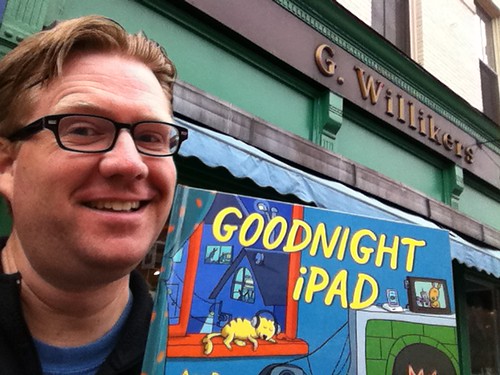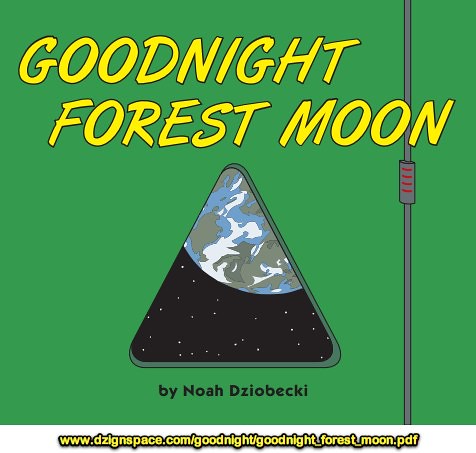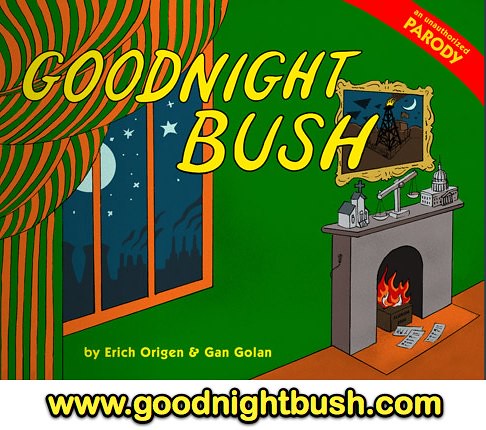Our family members have been fans of “Goodnight Moon” (by Margaret Wise Brown and illustrated by Clement Hurd) for many years. Prior to Christmas last year, I learned about David Milgrim’s clever “Goodnight iPad” book, which he wrote under the psyudonum “Ann Droyd.”
There are several other creative parodies of “Goodnight Moon” available in print, online, and on YouTube, so in this post I’ll share links to those I know about in the hope that you’ll share more and be inspired to share some of these with your students. Parodies can be excellent vessels for creativity, critical thinking, and literacy development.
To begin, it’s “wise” (pun intended) to get familiar with the Margaret Wise Brown original via the book’s English WikiPedia entry as well as a video version narrated by Susan Sarandon.
To keep things light and fun, next check out “Goodnight iPad” by Ann Droyd. Then add Richard Louv’s excellent book, “Last Child in the Woods: Saving Our Children From Nature-Deficit Disorder” to your reading list, along with Sherry Turkle’s book, “Alone Together: Why We Expect More from Technology and Less from Each Other.”
If you happen to be an older sci-fi fan and actually watched or read the book “Dune,” you’ll enjoy the video for “Goodnight Dune” by Julia Yu. (The video is not embeddable, but does play on her website with audio.)
Halloween is over now, but your students will likely still be amused by Michael Rex’s “Goodnight Goon.” An audio reading of the book (which doesn’t show the illustrations) is available on YouTube.
For Star Wars fans, Noah Dziobecki‘s amazing (and free) PDF of “Goodnight Forest Moon” will delight. He even published a thorough assembly guide if you’d like to make your own “board book” version. Content is based on Wookieepedia, in case you were wondering.
Now it’s time to get political, as many parodies do, and it’s entirely possible you might offend someone if you share one of these last examples. You also might invite them to think critically about our political process and political leaders too, so consider that theoretical benefit as you weigh alternatives.
“Goodnight Democracy” (also available as a free PDF) is a Rootstrikers project and web-based book. If you and your students are not already familiar with “Citizens United v. Federal Election Commission,” this book will hopefully inspire some follow-up reading. If you noticed some big changes in campaign advertising in the United States during our recent election, you hopefully know a lot of the blame goes to Super PACs. The issues here are BIG, not small, and parody can be used to raise awareness. Cognitive dissonance can be a powerful catalyst for critical thinking. The Rootstrikers Resource page has a good list of additional resources to investigate as well as share. Larry Lessig‘s book, “Republic, Lost: How Money Corrupts Congress–and a Plan to Stop It” is a great place to start.
On a similar but different political note, “Goodnight Bush” is another political parody of Brown and Hurd’s children’s classic which celebrates the end and laments the lasting negative effects of the presidency of George W. Bush. Whether you’re in a red state or a blue state (or not in a colored state at all) you can invite some lively discussion in your social studies class asking whether the portrayal of Dick Cheney as “the old lady whispering hush” is fair, since Noah Dziobecki used a Sith Lord as that character in “Goodnight Forest Moon.”
The final “Goodnight Moon” parody I’ve seen in print and online is “Goodnight Keith Moon.” Keith was the drummer for “The Who.” The references to urination and vomiting in the book make this one fall into the “not appropriate for class” category in school contexts, but it’s still worth checking out if you’re wanting to exhaustively research the “Goodnight Moon parody genre.” A version is also available on YouTube.
What other Goodnight Moon parodies have I left off of this list? Have your students seen many of these? Could you use these to inspire students to write their own parodies? If you do, please let me know via a comment or tweet!
Long live parodies, creative writing and fair use!





